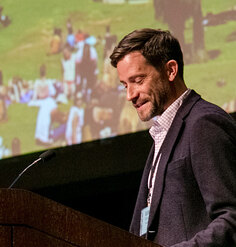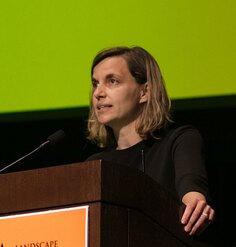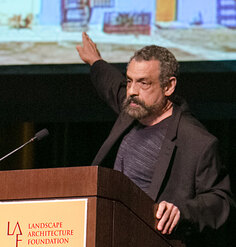Landscape Beyond the Biotic
By Christopher Marcinkoski
This presentation was part of the Landscape Architecture Foundation’s The New Landscape Declaration: A Summit on Landscape Architecture and the Future held in Philadelphia on June 10-11, 2016. LAF asked a diverse group of leading minds to write a “Declaration” reflecting on the last half century and offering bold ideas for how landscape architecture can make its vital contribution in response to the challenges of our time.
Christopher Marcinkoski
Associate Professor, University of Pennsylvania
Philadelphia, Pennsylvania
Christopher Marcinkoski is associate professor of landscape architecture and urban design at the University of Pennsylvania. He is a licensed architect and founding director of PORT, a public realm and urban design consultancy based in Philadelphia and Chicago. He holds a bachelor of architecture from the Pennsylvania State University and a master of architecture from Yale University.
* Affiliation at the time of the Summit
Landscape Beyond the Biotic: In Advocacy of a Revised Litany
by Christopher Marcinkoski
Ian McHarg often wrote and spoke of what he termed his litany: the various subject matters and concerns that he believed all landscape architects should actively engage in their work. That litany forms a central tenant of the 1966 Declaration of Concern, with McHarg and his colleagues arguing that students and practitioners “must know geology, physiography, climatology, [and] ecology to know why the world’s physical features are where they are; and why plants, animals, and man flourish in some places and not in others.” The declaration asserts that only once designers are able to “interpret” a landscape through these lenses are they properly prepared to plan and design the environment. The 1966 declaration, in essence, advocates that landscape architecture be understood as an applied arm of the natural sciences, ostensibly setting the intellectual orientation and interests of the discipline for the last half century.
While the logic behind this declaration is understandable, given the discipline’s widely accepted origin story, not to mention the particular cultural moment in which it was written, I choose to reject it as far too narrow in scope to continue to serve as a useful disciplinary apparatus. For example, rather than what McHarg suggested would be the “emancipation” of landscape architecture, I contend that the discipline’s strident subscription to biotic ecology above all else has unnecessarily shut out discussions of other essential landscape concerns, which has served to limit the discipline and prevent it from achieving a much greater and more significant cultural agency over the last half century.1 As such, I suggest that now is an ideal time to establish a revised litany for the twenty-first-century landscape architect, one that is far more multivalent than the original declaration.
To begin, I would advocate a revision that centers less on purely environmental interests and more on developing a deeper awareness and understanding of those political, economic, and sociocultural machinations that motivate the urbanization activities at the center of the discipline’s current and future work. Active engagement with the underlying drivers and impulses of urbanization is as important as endeavoring to limit, soften, or undo their effect. Such an approach serves to extend the discipline’s field of engagement while simultaneously expanding its rhetorical kit and its means of evaluation.
I make this assertion as someone who is not formally trained as a landscape architect but rather as someone who came to the discipline because of what I saw as its potential capacity for dealing with urban issues. Particularly compelling is landscape architecture’s latent facility to negotiate and synthesize a variety of competing and often contradictory concerns—economic, social, cultural, and yes, environmental—into actionable strategies and solutions, both physical and procedural. In this regard, landscape as a disciplinary apparatus offers a powerful set of instruments for navigating the myriad challenges related to the future urban condition if, and only if, it escapes the burden of advocating and evaluating its work solely through environmental terms, or the now seemingly de rigueur ecological terms. While such a contention may be viewed as heresy, I believe it is a necessary truth that the discipline must confront in order to preclude landscape architecture from being reduced to a technical vocation, rather than elevating it to an essential cultural project.
To substantiate this argument, I would like to sketch out three tenets upon which it is predicated.
First, we must accept that the conceptual binary of urban and nonurban that the 1966 Declaration of Concern relied on is no longer valid. To paraphrase Henri Lefebvre, all that is affected by anthropogenic concerns is made urban and, as such, the entire landscape of the earth as we know it today, both physically and conceptually, must be understood as an urbanized condition of varying intensities. As a result, the fundamental question confronting planners and designers is no longer a matter of where, but rather a question of how. That is, how does one go about influencing, managing, or negotiating the intensity, formats, and consequences of the innumerable anthropogenic regimes that are continuously remaking the landscape of the earth? Such questions simply cannot be answered by relying solely on the natural sciences as our guide. Rather, we must look to the broader motivations and drivers of the regimes to uncover how landscape architecture might actively engage, infiltrate, inflect, and influence them.
Second, urbanization activities, particularly the construction of new settlement and infrastructure, have long been understood as the physical manifestation of economic growth. However, this correlation can no longer be accepted as valid. Urbanization activities are increasingly the result of speculative motivations, deployed as catalysts in pursuit of uncommon economic gain and righteous projections of political power. The result is a rapid and radical remaking of the earth’s physical landscape, particularly in those polities deemed “emerging.”2 Demographic and market realities have given way to highly speculative pursuits focused almost exclusively on the physical products of urbanization, treating them as transactional instruments necessary to elevate global status. Given the artificiality of their demand, these speculative activities have a high propensity for failure—left incomplete or abandoned, made inaccessible, or suffering from pervasive vacancy—and in turn, result in both severe near-term and long-term consequences. The implication is that planners and designers can no longer train their attention solely on the preferred outcome of their work, given the increasingly low likelihood of these pursuits coming to fruition. Rather, the work must pursue active mechanisms of adjustment, modulation, and contingency, as well as the potential for abandonment or repurposing. In order for design and planning to produce these more dynamic formats of urbanization, they must be cognizant of and actively engaged with the systems and agendas motivating these urbanization activities in the first place.
Third, while it is encouraging to see an increasing number of schools and practitioners looking at expanding the discipline’s topics of concern beyond the traditional scope of the landscape architect, far too much of this recent work has been centered on the wholesale replacement of existing formats of settlement and infrastructure in pursuit of novel systems conceived of almost exclusively from self-described ecological concerns. The ambition is commendable, but the potential erosion of cultural credibility that the discipline risks in promoting these kinds of projects is not. Instead of advocating naïve totalizing visions, I encourage the pursuit of strategies of inflection, appropriation, and subversion. Even though such an approach may be slower and perhaps rhetorically less dramatic, its capacity to produce real, fundamental, and established influence is far greater. To discover these moments of potential operation—locations of loose fit or slippage or surplus—it is essential to again understand the fundamental principles that have motivated the construction of these extant systems of urbanization. The natural sciences do provide one lens, but searching for potential means of intervention under these terms alone is unnecessarily reductive. However, if the field of disciplinary operation is expanded beyond its preoccupation with biotic ecology to include political, economic, and sociocultural concerns, significantly more opportunities for potential action quickly come into focus.
I do not make these assertions to diminish the environmental concerns that have typified the work of landscape architecture over the past half century. Rather, my interest is in elevating other fundamental urban concerns to a commensurate status in order to move landscape architecture beyond its unnecessarily limited focus to a more multivalent, actionable, and efficacious orientation.
If landscape concerns are to have a truly central role in the ongoing processes of urbanization being seen globally—for them to function as physical structuring devices, conceptual organizing logics, or actionable policy instruments, and not simply as tidy little neoliberal ornaments of green—they must be argued for and explained in the sociocultural, economic, and political terms of global urbanization. Only then will landscape architecture begin to approach its potential as a truly essential cultural project.
1. Ian L. McHarg, “An Ecological Method for Landscape Architecture,” Landscape Architecture Magazine, January 1967: 105-107.
2. Christopher Marcinkoski, The City That Never Was (New York: Princeton Architectural Press, 2016).











